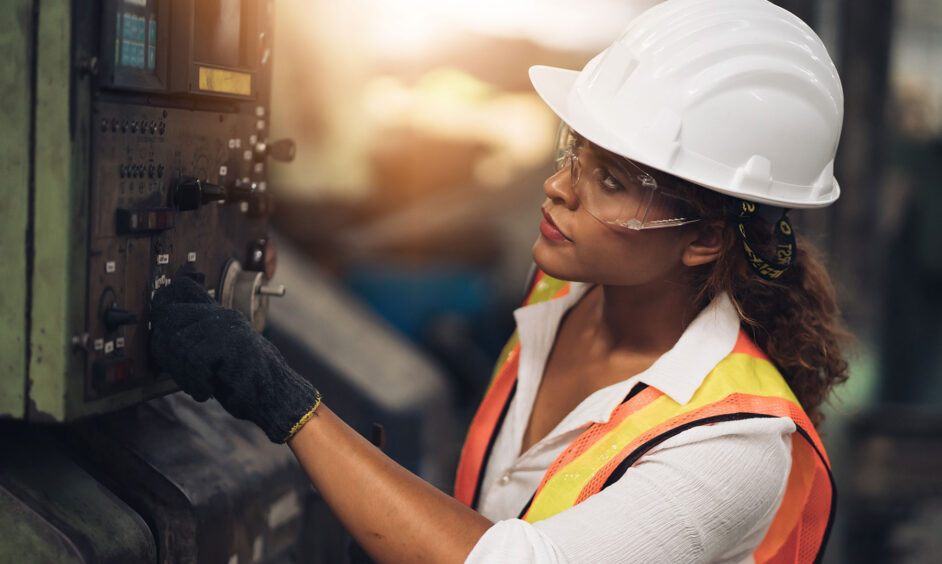While more and more companies are embracing diversity and inclusion as part of how they do business, the construction industry continues to struggle. Learn why, and hear one woman’s perspective on how to achieve positive change.
“Diversity and inclusion” has become an increasingly popular topic in recent years. We hear this term more and more, but what exactly is “diversity and inclusion?” Diversity and inclusion are often used together; however, they have two distinct meanings. According to the online tech industry hub, Built In, “Diversity refers to the traits and characteristics that make people unique, while inclusion refers to the behavior and social norms that ensure people feel welcome.” In the words of Verna Myers, author and thought leader, “Diversity is being invited to the party. Inclusion is being asked to dance.”
While diversity comes from a broad range of differences among all people, in the construction industry, we mainly look at the variety of people representing gender, race and age.
Why Does Diversity Matter?
Diverse teams are a sign of healthy and inclusive culture. Diversity helps an organization by increasing innovation and creativity. As different backgrounds, perspectives and values are brought in, the company becomes stronger, more robust and innovative. In a January 2020 Forbes article on the impact of diversity on innovation and financial results, Stuart Levine writes, “Diverse teams are better positioned to unlock innovation that drives market growth.” Levine further states that companies with greater diversity increase innovation revenue by 45%.
Diversity also helps organizations drive increased profitability due to greater employee engagement, attendance and performance. The 2013 study conducted by Boris Groysberg and Katherine Connolly of Harvard Business School determined that employees of diverse teams feel more comfortable, valued and respected. They’re also more motivated to contribute to the success of the company and have higher engagement in problem-solving and decision-making, all of which leads to higher retention.
Finally, diverse companies make better decisions by reducing groupthink. (Groupthink happens when a group of well-intentioned people make less-optimal decisions because of the urge to conform, or they believe dissent is impossible. It may be fueled by a particular agenda or simply because group members value harmony over critical thought.)
For all of these reasons, diversity and inclusion are highly beneficial to both employers and employees. However, the construction industry continues to face a greater challenge in increasing diversity, specifically with women and minorities.
Women in Construction
While more and more companies are embracing diversity and inclusion as part of how they do business, the construction industry continues to have an extremely low representation of women.
According to the 2019 U.S. Bureau of Labor Statistics, women make up only 10.3% of the construction workforce. Of that percentage, the majority of women work in office positions, not in the field. In the field, the statistic is worse—only one woman to every 20 men.
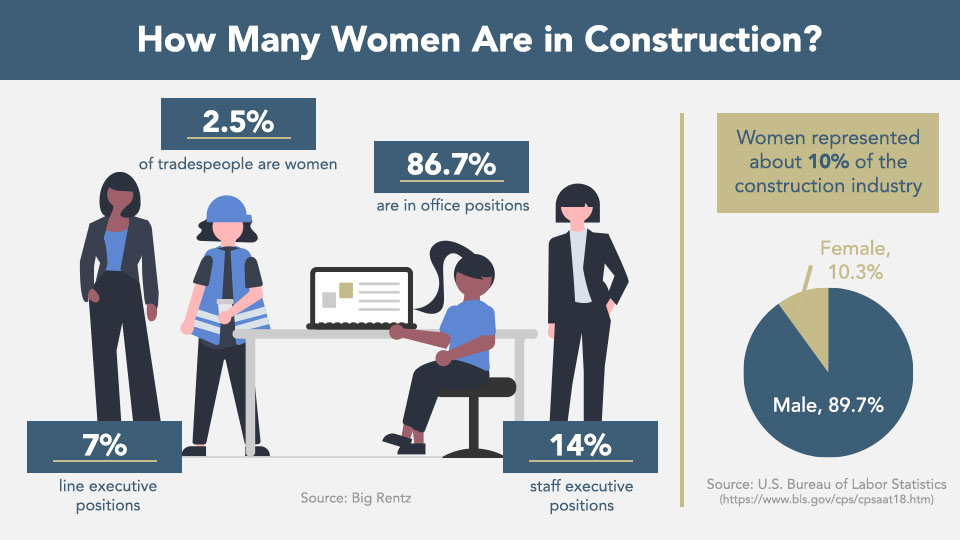 Believe it or not, women have been a part of the construction industry since the late 1800s. The first documented woman in construction was Emily Roebling, who took over as a field engineer on the Brooklyn Bridge when her husband became ill. Another notable woman was industrial engineer Lillian Gilbreth, who was accepted into the American Society of Mechanical Engineers in 1926. Fast forward to 1979, when Barbara Res was placed in charge of the construction of Trump Tower.
Believe it or not, women have been a part of the construction industry since the late 1800s. The first documented woman in construction was Emily Roebling, who took over as a field engineer on the Brooklyn Bridge when her husband became ill. Another notable woman was industrial engineer Lillian Gilbreth, who was accepted into the American Society of Mechanical Engineers in 1926. Fast forward to 1979, when Barbara Res was placed in charge of the construction of Trump Tower.
Race in Construction
Not only is construction one of the most male-dominated industries, racial demographics show that it’s white men who remain the majority workers in 2019. Here are charts for various racial groups.
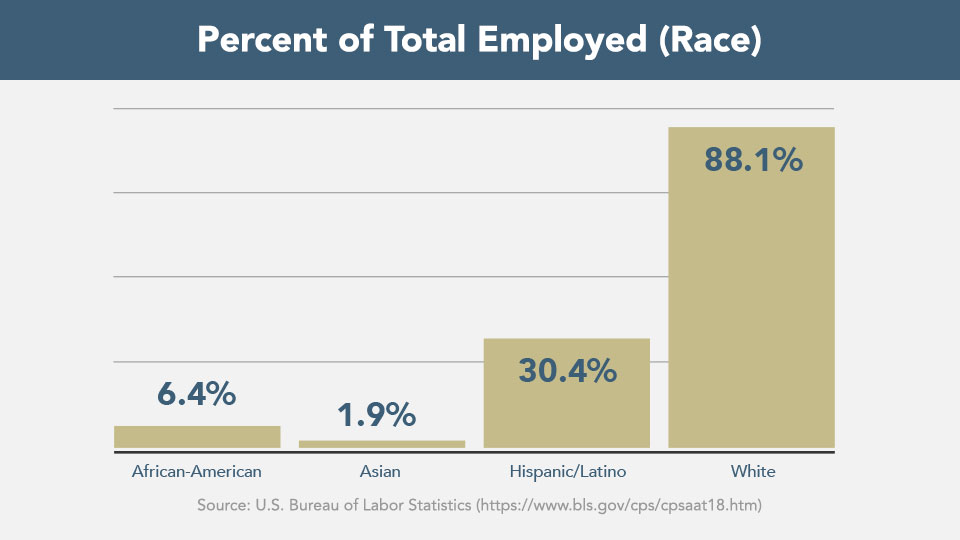
There is even greater imbalance when we look at minority women within the industry. In 2017, only 4% of women in construction were African American, and in 2015, less than 5% of Hispanic construction workers were women.
A Surprising Look Within
At CM Solutions, our core values are Leadership, Knowledge, Innovation, Integrity and Community. Diversity and inclusion are paramount to truly embodying these values. As we started to ask questions about diversity, we realized that we didn’t even know our own statistics in terms of demographics and pay equity among those demographics. We gathered the data and took a deeper look within.
In terms of gender equity, our company is well balanced. Our internal demographics of women vs. men employed at CM Solutions is very close to a balance, with 43% women and 58% men.
Our company’s racial demographics, however, are more similar to what we see in the construction industry as a whole. The majority of our employees are white-European. If you consider that Middle Easterners often classify themselves as white, the number of “white” employees increases to 67.5% of the company. Although CM Solutions is a small company with some diversity across various racial/ethnic backgrounds, there is room for improvement.
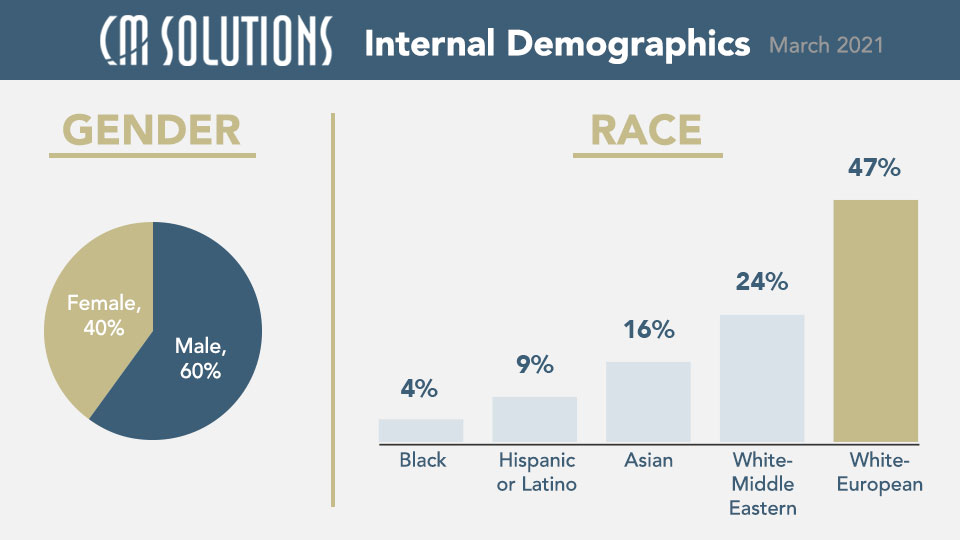
After considering demographics, we also looked at pay equity across those demographics. Although it was never our intention to be discriminatory with pay, we did find some situations that were not equitable and began making appropriate adjustments to correct them. Without an intentional look at the numbers, we wouldn’t have recognized these inequities and been able to make the adjustments.
Regarding inclusion, CM Solutions is a place where inclusion is part of the company culture and an outgrowth of our core value “community”. Titles and hierarchy are superseded by inclusivity, and all employees know that their contribution and engagement are vital to our company’s success. Leadership works hard to ensure employees feel comfortable, valued and respected. However, company leadership is also aware that their experiences are limited. With a greater awareness and commitment to diversity and inclusion issues, they created a new leadership role for a Diversity and Inclusion Officer.
The Gender Pay Gap and Race
In the construction industry, the gender pay gap is considerably less than many other industries. In 2018 the Bureau of Labor Statistics reported that women in construction earned an average of 99.1% of what men make, while across all industries, women earn an average of 81.1% of what their male counterparts make—which is considerably less. Although women in construction make wages that are close to their male counterparts, it’s unfortunate that women of color still make less than their male counterparts. Black women make just 81% of what white men make, while Hispanic women make only 53.3% of the pay of their white male counterparts.
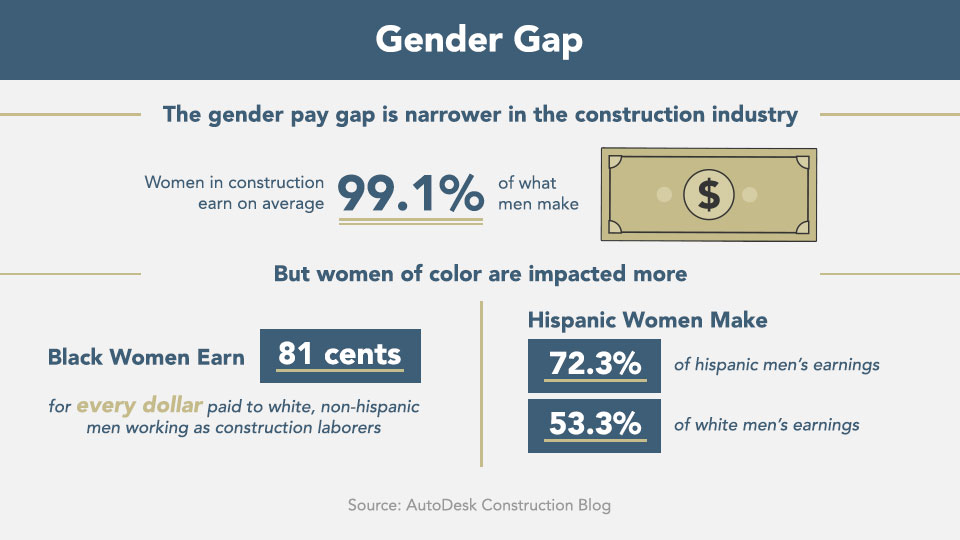
Making the Future Brighter
Women and minorities are looking toward business ownership as another way to help level the playing field. The number of women- and minority-owned construction firms is growing.
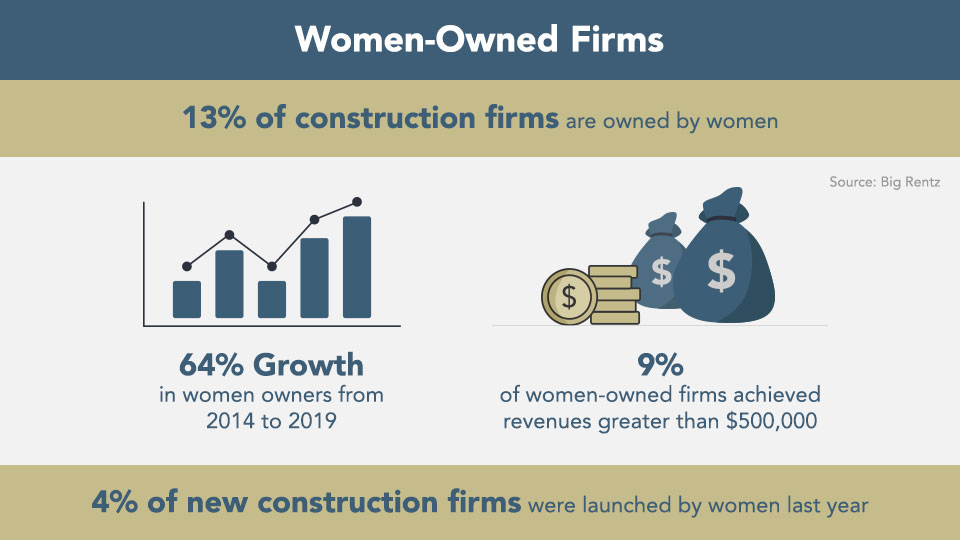
Minority-owned firms grew from 14% in 2007 to 23% in 2012 in the residential construction industry. CM Solutions is a certified small, local, disadvantaged, woman-owned construction project controls firm. As it grows, our company has increasing opportunities for greater diversity. CM Solutions partners with other small and diverse businesses, as well as with larger non-certified firms, to bring project control solutions to construction management firms, contractors and public agencies.
A Call to Action
Efforts are being made in the construction industry to change these disparities in diversity. There are many organizations focused on increasing opportunities for women and minorities at all levels of the industry. They also provide training, education, mentorship, networking, advocacy and access to opportunities.
Some of these resources for women in construction are:
- National Association of Women in Construction (NAWIC)
- Women in Construction Operations (WiOPS)
- Women Construction Owners & Executives USA (WCOE)
- WTS International
- Tradeswomen.net (Run through the Oregon Department of Transportation)
Resources for minorities include:
- National Association of Minority Contractors (NAMC)
- U.S. Minority Contractors Association (USMCA)
- Diversity Resource Groups of the Associated Builders and Contractors (ABC)
- National Black Contractors Association (NBCA)
- National Association of Black Women in Construction (NABWIC)
- National Hispanic Construction Association (NHCA)
- Asian American Contractors Association (AACA)
- Chinese American Construction Professionals (CACP)
As an employee, the best way to get involved personally is to speak to your employer about your interest in joining one or more of these organizations. Your employer may already have a corporate membership, and others in your company may be individual members. As long as membership is related to the industry, most employers will encourage employee participation. Employees of CM Solutions are members of WTS International, Construction Management Association of America (CMAA), and the Association for the Advancement of Cost Engineering (AACE), among others. If you aren’t currently a member of an organization promoting the increase of women and minorities in our industry, I would encourage you to get involved.
How can we all increase the number of women and minorities in the various areas of construction?
The answer is simple: increase awareness. In an industry that’s predominantly white and male, construction-related companies need to do their part to increase diversity. There’s already a strong push to increase the number of women and minority workers—now we just need momentum. Some great programs include:
- Pre-apprenticeship programs targeting women, minorities, youth, and the formerly incarcerated that help prepare individuals for careers in the construction industry.
- HireLAX provides residents local to LAX (Los Angeles International Airport) the opportunity to enroll in a comprehensive, construction apprenticeship preparation program.
- Women in Non-Traditional Employment Roles (WINTER) focuses on preparing women for careers in construction.
- The Associated General Contractors of America (AGC) is launching a campaign targeted at diversifying the construction industry. An article published in February 2019 by The Architects newspaper cited ACG as stating, “By familiarizing high schoolers and college students with vocational training… the association hopes to boost the diversity of the industry.”
The best way to learn more about these programs, as well as many others, is to spread the word.
Children Are Our Future
Many who work in the construction industry believe that the best way to diversify its future workforce is by heavy outreach to youth. Some programs work with students as early as elementary and middle school. There’s also a strong need to bring vocational education and training back to high schools. While college prep remains at the center of high school curriculum, only 68% of high school students attend college, according to the U.S. Bureau of Labor Statistics. That means over 30% of high school graduates leave school without higher level education or job skills.
Why not prepare these students for a career in construction? Through STEM/STEAM programs, internships, vocational training, mentoring and simply more positive discussions about careers in the construction industry, youth can discover opportunities to choose a path that may be better suited for their natural skills and talents. College is not for everyone, and the pay in construction is comparable to many careers that require a college degree.
My Story
Construction is very personal to me; it’s in my blood. I’m the granddaughter of a minority contractor and small business owner of a neighborhood hardware store. I cherish every opportunity I have to share my experience and love for the construction industry with others, especially minority female youth. I have participated in several career days and events that focus on introducing high school students to careers in construction. I believe that bringing continued exposure and awareness to youth will show them an alternative path, which is key to diversifying and increasing the pool of construction industry professionals.
As we’ve seen, the entire construction industry needs to do more to recruit and retain women and minority professionals as business owners, employees and workers. I’m extremely proud to be an African American woman in construction, and will continue to be part of the driving force that is working to diversify this industry while making it an inclusive place for everyone.
Shanette Anderson has been with CM Solutions since 2019 serving as the Business Inclusivity Analyst & Engagement Specialist for the Los Angeles World Airport’s Business Jobs and Social Responsibility Division. She recently added the role of Diversity & Inclusion Officer for CM Solutions. Much of Shanette’s career has been spent advocating for small, local, disadvantaged, minority, and women-owned construction companies, where she supported their business development with government contracts. Shanette has a BA in Organizational Leadership and a certificate in Diversity & Inclusion from Cornell University.
References
Chatlani, S. (2016, August 2). Filling the void: How Construction Executives Can Embrace Diversity in an Evolving Workforce. Retrieved from Construction Dive.
Connley, C. (2019, January 29). Just 9.1% of America’s Construction Workers Are Women—Here’s What It’s Like to Be One of Them. Retrieved from CNBC.
Construction Chart Book: Labor force Characteristics Hispanic Workers in Construction Occupations. (n.d.). Retrieved from CPWR Center for Construction Research and Training.
Current Population Survey. (n.d.). Retrieved from Bureau of Labor Statistics.
DATA USA. (n.d.). Retrieved from Construction Laborers.
Diversity and Inclusion: Definition, Benefits and Statistics. (2019). Retrieved from BuiltIn.
Dnika J. Travis, E. S.-M. (2019). Getting Real About Inclusive Leadership: Why Change Starts With You . Retrieved from Catalyst.
Economics Employment. (n.d.). Retrieved from Black Demographics.
Ellis, G. (2020, March 5). Level the Jobsite: Why We Need More Women in Construction. Retrieved from Autodesk Construction Blog.
Flavell, S. (2019, May 21). 3 Reasons Why Diversity and Inclusion Matter at Work. Retrieved from FDM.
Groupthink. (n.d.). Retrieved from Psychology Today.
Haselden. (2018, May 25). History of Women in Construction. Retrieved from Haselden Construction.
Inclusion and the Benefits of Diversity in the Workplace. (2014, March 6). Retrieved from Talent Intelligence.
Levine, S. R. (2020, January 15). Diversity Confirmed To Boost Innovation And Financial Results. Retrieved from Forbes.com.
McEvoy, A. (2017, February 17). NEREJ. Retrieved from The History of Women in the Construction Industry, and How Far They Have Come.
Miller, R. (n.d.). Why You Should Care About Diversity and Inclusion. Retrieved from Wavelength.
Oriaku, A. (2019, February 25). Construction Industry Launches Campaign to Diversify National Workforce. Retrieved from The Architect’s Newspaper.
Seger, C. (2018, August 29). Viewpoint: The Continuing Rise of Women in Construction. Retrieved from Engineering News Record.
Wyman, N. (2015, September 1). Why We Desperately Need To Bring Back Vocational Training In Schools. Retrieved from Forbes.com.
Zitman, L. (2020, January 27). Women in Construction: The State of the Industry in 2020. Retrieved from Big Rentz.
 Back to news
Back to news